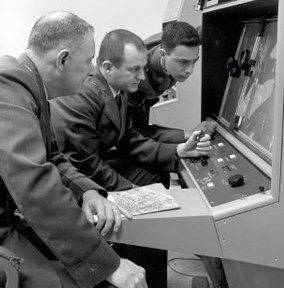
Science, ultimately, is the effort to answer a childish question: how does everything work? Marie Curie once said that a scientist in the laboratory is “a child placed before natural phenomena which impress him like a fairy tale”. We can’t delve straight into the question of why we are here, of course; we have to split it into bite-size parts. Why does the sun appear and disappear every day? Why does a bicycle stay upright? What keeps me pinned to the ground? What are those lights in the sky at night? But, as George Bernard Shaw once pointed out, science never answers a question without inviting ten more: investigate those questions and you are forced to deal with myriad others. Does the sun orbit the earth, as it appears to from our perspective? Then: what other aspects of our naive perception present us with entirely erroneous impressions of the world?
The ultimate answer to this last question is found in atomic physics. First we thought the atom was the fundamental building block; then we discovered you could break it up into constituent parts. Around the same time we discovered that those parts are themselves baffling to our intuition: they can exist in two places at once, or share a seemingly telepathic connection that links their properties. This phenomenon, known as entanglement, was so abhorrent to Einstein that he labelled it “spooky action at a distance” and refused to believe it could be real. It wasn’t an entirely unreasonable reaction – the jury was out for roughly half a century. But in the 1980s some ingenious physicists found an answer to the question of how we prove whether entanglement is real or not – and showed that it was. Ever since, we’ve been finding ways to put it to work. You can already buy quantum cryptography systems that use entanglement to protect the security of communications and financial transactions. Even if making money is not the point, the search for answers has a habit of paying for itself.
Not that physics has answers that satisfy everyone. Many people are happier to take religious answers, for instance. When asked why we are here, the Dalai Lama invokes a “limitless number of universes” and a self that “has existed from beginningless time”. For many, that is a thought-provoking and satisfying answer. Palaeontologist Stephen Jay Gould had a different take: we are here, he said, “because one odd group of fishes had a peculiar fin anatomy that could transform into legs for terrestrial creatures; because the earth never froze entirely during an ice age; because a small and tenuous species, arising in Africa a quarter of a million years ago, has managed, so far, to survive by hook and by crook.”
Both of these approaches invite a further question: “how do you know?” Here we find a difference between the approaches: religious contentions are taken on trust but scientific contentions are tested. Gould’s contention about the fin anatomy of fishes, for example, can be investigated: we can look for evidence in the fossil record.
One of the greatest recent successes of evolutionary theory came in 1998, when two researchers decided to go in hunt of the evidence supporting the contention that the first fishes moved onto land about 375 million years ago. They used a geology textbook to locate rocks from this period, and learned they could be found at Ellesmere Island in the Canadian Arctic. So off they went to look for fossils – and found them. Thanks to this dogged pursuit of answers we now have fossil skeletons of Tiktaalik roseae, which provides us with an intermediate between fish and amphibians.
Such clean breakthroughs are rare, of course; science is mostly pain. Declarations such as “the joy of discovery is certainly the liveliest that the mind of man can ever feel” (Claude Bernard) must be tempered with the acknowledgement that “nearly all scientific research leads nowhere – or, if it does lead somewhere, not in the direction it started off” (Peter Medawar). Answering the bigger questions of physics is certainly a tougher job because you can’t always identify where even to start.
Take the biggest question of all, for example: what is the ultimate nature of reality? We used to think the answer was atoms. Then we learned about the electron and then about the atomic nucleus. Then it became clear that this nucleus was composed of protons and neutrons. Then these particles were discovered to be composed of quarks held together by gluons. And now we’re in trouble. We know these particles follow those strange quantum laws, and the consequences of this lead us towards an extraordinary answer to our very ordinary question.
At heart, quantum theory is about probabilities. No particle has a real existence that we can speak of; we can only express the probability of finding it somewhere. In fact, quantum theory is really about getting access to information.
Information is not an abstract entity. It is always encoded in something physical: a computer’s hard disk, say, or molecules of ink on a page. So if quantum theory is leading us towards the idea that information lies at the heart of reality, this information must be stored somehow in the physical universe.
Faced with such a staggering notion, scientists began to seek out the supporting evidence. And, though it’s very early days, it seems there is some.
A long-running spat between cosmologists Stephen Hawking and Leonard Susskind about the nature of black holes has given us new insights about where the universe stores its information. We now understand that the information contained in the stuff swallowed by black holes is stored at the event horizon, the spherical boundary that defines the black hole. This has led to the conjecture that all the information about the cosmos is stored at the universe’s boundary. There’s no restaurant at the end of the universe, but there is a recipe – a recipe for reality.
In this scheme, what we think of as reality is actually a projection of the information held at the universe’s boundary. The idea mirrors the way we can create a 3D hologram from information stored on a flat, two-dimensional surface.
And we can make predictions about the properties of such a “holographic universe”. One is that the universe should be filled with a certain kind of radiation. In 2008, researchers at the GEO 600 gravity wave detector in Hanover, Germany, picked up exactly this kind of signal (they initially thought it was just annoying noise in their instrument). To confirm the discovery, researchers at Fermilab in Illinois are now building a dedicated instrument that may well pick up the signature of the holographic universe.
Determining the ultimate nature of reality would be impressive – perhaps the most impressive thing physics can ever hope to achieve. But physics is not only about the big questions, and plenty of smaller questions are still in need of answers. While physicists might like to claim they are working on ultimate truths, the truth is they care about anything that furrows their brow. That’s why Richard Feynman once spent time figuring out the equations behind a wobbling plate he had observed in the cafeteria at Cornell University. Physics is a home for the incurably curious; its practitioners are the children who never learned to grow up and stop asking questions.
Can We Travel Through Time? The 20 Big Questions in Physics by Michael Brooks is published by Quercus

